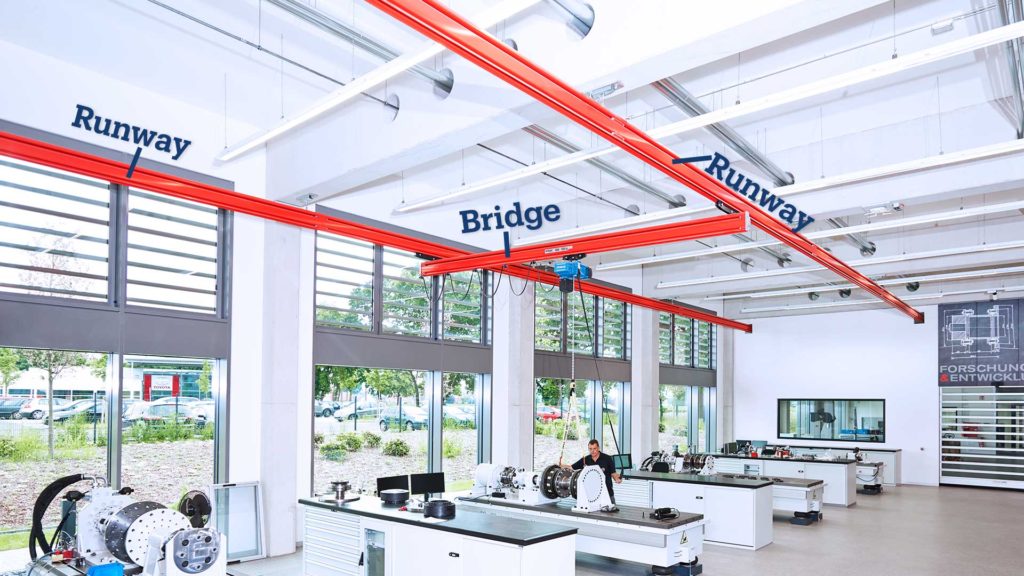Flow of materials through your manufacturing facility is critical to your manufacturing throughput success. The requirements of each project are unique. When these processes include lifting, it is important you find the solution that meets your exacting requirements. Focusing on loads under 2 Tons, lifting capabilities can be wide and tailored to your needs. As you start to define your unique needs to meet your process requirements, read more about the capabilities of light lifting products.
Monorail versus Crane
Both cranes and monorail lift and move loads for your workforce. Each offers specific benefits depending on your requirements. An enclosed track crane or monorail system can be equipped with lifting devices like chain hoists or balancers to lift the load as it travels to its destination.

Linear Motion with Monorail
Monorail systems help your workforce move loads in linear motions, forward and backward underneath the suspended monorail. Its compact construction and easy integration with existing workstation cranes, overhead cranes, and jib cranes make transferring products throughout your factory easier. Monorails can make your operations safer. It can eliminate manual lifting processes, loading and unloading products, and minimize forklift traffic in your building.
Monorail systems are found in nearly every industry and kind of manufacturing. Whether your needs are simple or complex, monorail systems fit a wide range of requirements. Monorails can be routed throughout your operations with curved track to deliver goods around corners, acting as a delivery system within a factory or plant.

As your requirements get more complex, monorail supports complex material flow solutions. Track switches, turntables and other material flow components can cater to complex material flow systems, like those found in the aviation industry. In addition, you may find monorail system delivering product into paint booths, assembly line areas, transfer system storage areas and more.

Enclosed Rail Track Cranes
Unlike a monorail system, cranes allow for lifting and motion on the X, Y, and Z axis. A crane consists of a runway on each end of a bridge. A lifting device moves across the bridge. Operators can lift and move loads under the rectangular area underneath the crane. Overhead cranes with enclosed rail track can be ceiling mounted, a freestanding workstation, or a combination of the two.
Unlike a monorail, modular crane systems allow for lifting within a rectangular area directly under the crane. Enclosed rail cranes are found in nearly all manufacturing industries. These lifting devices can make assembly processes more efficient when building a large component or assembling many items with a freestanding workstation crane. Ceiling mounted cranes are mounted to the structural steel of your building. These cranes have capacities up to 3.5 Tons, depending on the evaluation of the building’s structural steel.
Extending Lifting Capabilities Outside the Crane Area

With lifting and movement happening on the X, Y, and Z axis of a crane, your manufacturing processes may change over time requiring lifting outside the existing crane area. Cranes can be expanded by adding additional runway or even connecting to another modular crane system. This expansion adds lifting capabilities to areas around the crane.
Depending on where you need to expand or extend your lifting outside of the crane area, an extending crane may be the solution. This device is added to your existing bridge. It has a segment that can extend outside of the runway area when required. An extending device like this has limitations, but it can add lifting capabilities closely outside of the runway. Additionally, routing a monorail system to transfer the load could be a solution. The load would be set down in a specific area on the end of a crane and then picked up with the lifting device on the monorail system.

Manual versus Powered Trolley and Bridge Motion
Once a load is lifted, it needs to be transported to the next position. Moving a load on a lifting device with a trolley or the crane bridge itself can be accomplished manually or powered. Manual trolleys and bridge trolleys require the operator to carefully initiate and stop movement. No power is required for manual movement so there is a load weight limitation that will come into consideration.
Powered trolleys for lifting devices and bridge trolleys are connected into the electrical panel of the crane. Movement is controlled by the operator with a pendant or radio. The travel speed of the trolley can be determined with your experienced crane manufacturer or crane dealer in order to meet your application requirements.

Automation with Crane and Monorail Systems
Automating a lifting process can bring benefits to your operations. Both monorail systems and crane systems can be semi or fully automated. By adding components like electric tractor motors, sensors, PLCs, geared limit switches, and encoders, you can automate the crane or monorail and the lifting device attached. Read more about automation on light crane equipment here.
When your requirements are lifting and moving light loads under 2 Tons, there are a number of solutions to meet your needs. Monorail systems and light crane systems can allow you to lift and transport loads in different ways to meet unique requirements. Motion can be accomplished through manual or powered trolleys. Automation can even further expand your throughput in your entire facility or manufacturing plant.
Talk to our experts learn more about light lifting solutions to meet your needs. Go to our website or use the form at the top of this blog post.
